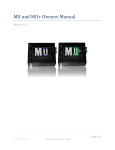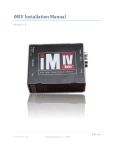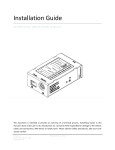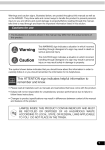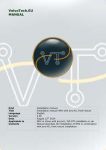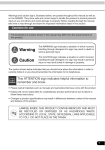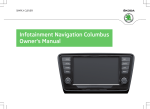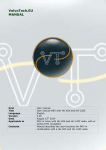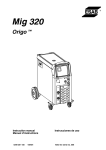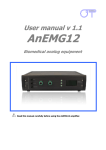Download Manual - iMIV.ca
Transcript
Content
1
Manual
Version 0.95
Introduction ..........................................................1-1
1.1
Main Setup ..................................................1-2
2
Installation Manual ...............................................2-1
3
User Manual.........................................................3-1
3.1
Getting started.............................................3-1
3.1.1 iPod operation.........................................3-2
3.1.2 AUX input operation................................3-4
3.2
iPod operation .............................................3-6
3.2.1 HU display...............................................3-7
3.2.2 Connect/ disconnect your iPod ...............3-7
3.2.3 Simple Mode ...........................................3-8
3.2.4 Advanced Mode ......................................3-9
3.2.5 Switching between Simple Mode and
Advanced Mode .................................................3-20
3.2.6 Resuming..............................................3-21
3.2.7 Ignition on/off ........................................3-23
3.3
Service mode ............................................3-24
3.3.1 Setting the adapter in Service Mode ....3-24
3.3.2 Uploading Firmware..............................3-25
3.3.3 Displaying service information ..............3-28
3.3.4 Emergency procedure for uploading
firmware .............................................................3-29
3.4
AUX operation...........................................3-33
3.5
VIDEO operation .......................................3-35
3.5.1 RTI and video signal .............................3-37
3.5.2 Steering wheel controls and TV channel .. 339
3.5.3 iPod Video version................................3-40
4
Warranty, Disclaimer, Liability and Trademarks ..4-1
4.1
Warranty......................................................4-1
4.2
Disclaimer and Liability ..............................4-3
4.3
Trademarks .................................................4-4
Appendix A: Compatibility
Appendix B: Troubleshooting
Manual
Version: 0.95
Date: October 15th 2006
1 Introduction
Thank you for purchasing the iMIV-Volvo adapter!
THIS
PAGE
IS
LEFT
INTENTIONALLY
BLANK
By reading this manual and using the adapter, you’ll soon
find that this adapter has the most feature rich and multipurpose functionality of any available adapter. The iMIVVolvo takes full advantage of the extendible Volvo audio
system and was designed to seamlessly integrate into
the factory audio and video components without any of
the limitations found in similar products.
The adapter’s main features are listed in Table 1.
Seamless Integration into the OEM Volvo audio
system
•
•
•
•
•
1
Works with RTI (navigation) and external CDChanger1 present
All HU-xxx models supported (S40(classic), V40,
S60, V/XC70, S80)
User selectable HU-channel configuration. The
iPod can be controlled via CD-C OR MD-C and
VIDEO/AUDIO integration through the TV
channel
ALL described iPod features controlled via HU.
Steering wheel controls can be used to select
tracks and playlists
Integration of VIDEO and AUDIO utilized via the
HU TV-channel
External CD-Changer cannot be used with HU-850 or HU-650 radio.
© Sensolutions, Inc.
1-1
Chapter 1
Introduction
Manual
Version: 0.95
Manual
Version: 0.95
Date: October 15th 2006
Date: October 15th 2006
Rich adapter functionality
•
•
•
•
•
•
Support for all iPod models (iPod 1G1, iPod 2G,
iPod 3G, iPod mini, iPod 4G, iPod Photo, iPod
Nano, iPod Video)
Two modes of iPod operation controlled via the
HU: Simple and Advanced. Playlist control for up
to 99 playlists.
External VIDEO-input and audio input to connect
a DVD player, TV tuner, rearview camera, or a
PDA, gaming console, etc.
Supports the iPod Video, taking full advantage of
the audio AND video capabilities of the iPod.
Firmware is upgradable by simple downloads
and can easily be performed by the end-user
without removing the adapter.
AUX-input for additional audio source, available
on a separate HU-channel (e.g. MD-C or TV).
additional channels on the HU display. Genuine Volvo
devices can be chained together with the appropriate
cabling (or: wiring harness) which allows for multiple
devices to be connected to the HU.
The iMIV-Volvo adapter is designed to seamlessly
integrate into the Melbus and to respect other devices on
the bus.
Figure 1 gives an overview of the main wiring of the
adapter.
Table 1: Adapter’s main features
1.1 Main Setup
The main component of the Volvo audio system is the
HeadUnit (HU). It controls the internal audio devices
such as radio, cassette, CD-player, as well as the
external devices, like the CD-Changer, RTI and
Television. Each device has its own channel in the HU
and the external devices are connected via a proprietary
electrical bus system, called Melbus. All external devices
need to connect to this bus in order to operate correctly
and to allow control via the HU. Once connected, the
devices become known to the HU and are presented as
1
iPod 1G and 2G can be connected to the AUX input
© Sensolutions, Inc.
1-2
Chapter 1
Introduction
Figure 1: Main wiring of the iMIV-Volvo adapter
The iMIV-Volvo adapter contains a wiring-through
Melbus connector to link other devices. The adapter
connects to the HU using a standard Volvo Melbus cable
and connects to other Melbus devices with a standard
Melbus cable as well. Cars that have existing or prewired RTI, CD-CHGR or Satellite cabling, can use that
cable directly without any change or additional
© Sensolutions, Inc.
1-3
Chapter 1
Introduction
Manual
Version: 0.95
Manual
Version: 0.95
Date: October 15th 2006
Date: October 15th 2006
proprietary cables. The Melbus cable that is provided in
the package can be used to connect your adapter to the
existing Volvo audio system.
The iPod to adapter cable that is included in the package
uses a 13-pin DIN connector to connect to the adapter.
Don’t ever confuse this connector with the Melbus 13pin
DIN connector, which is used by Volvo for wiring through
Melbus devices! The iPod cable provides audio, video
and control signals from the iPod to adapter and no
additional cables are needed for a fully integrated iPod
audio and video solution. This cable can be used for all
iPods that have a dock connector.
The iMIV-Volvo adapter has an extra AUX-in RCA input.
This input can be used to connect e.g. a satellite radio,
PDA, additional MP3 player and other devices.
Furthermore, an external video source connected to the
yellow RCA connector, can be used in conjunction with
the AUX-input. This setup can be used to connect
peripherals such as a DVD player, PDA, carputer, game
console, rear view camera, etc.
The green video output connector on the adapter can be
connected to the RTI system or to a separate external
TFT display to display video. The video input requires a
PAL composite video signal if the output is connected to
the RTI system. The video source can be either PAL or
NTSC when the external TFT panel is used and depends
on the input signal capabilities of the TFT panel only.
A special VIDEO-out cable can be purchased from
Sensolutions that connects the adapter to the RTI. This
cable, together with special adapter firmware (which is
pre-installed) allows for two video sources (iPod and an
external video input) to be available on the HU’s TV
channel and the built-in RTI navigation display.
car. Changes and updates can be made without
removing and sending it back to the manufacturer. New
features are made easy! The firmware is upgraded by
initializing a firmware upload sequence and then playing
a special music file on the iPod. Various firmwares are
available that allow different configurations of the iMIVVolvo adapter and the Volvo audio system. See section
3.3.2 for further information about upgrading the
firmware.
The iMIV-Volvo adapter integrates the iPod and
AUX/VIDEO inputs, each on their own HU channel. Table
2 shows the channels that can be used for each input.
iMIV-Volvo input
HU channel
CD-CHGR
MD-CHGR
CD-CHGR
AUX only input(no video) MD-CHGR
TV
AUDIO/VIDEO input
TV
Table 2: Different HU channels can be used
by the iMIV-Volvo adapter
iPod
Each combination of channels is activated by
downloading the appropriate firmware. For example, if
the video capabilities of the iMIV-Volvo are to be used,
the TV channel is utilized for both AUDIO-input and
VIDEO-input.
It is not possible to use the same channel for both the
iPod and AUX or AUDIO/VIDEO input.
The iMIV-Volvo adapter is designed with the capability to
upgrade its firmware, while the adapter is installed in the
© Sensolutions, Inc.
1-4
Chapter 1
Introduction
© Sensolutions, Inc.
1-5
Chapter 1
Introduction
The iMIV-Volvo adapter also needs a power connection
to operate and should be closely located to a good,
permanently battery power source or connection.
2 Installation Manual
The basic installation steps to install the iMIV-Volvo
involve:
1. Choosing a location for the adapter
2. Connecting the adapter to the HU
3. Installing the iPod cable
4. Connecting the adapter to battery power
5. Uploading the appropriate firmware if necessary
Installation Step 1: Choosing
location for the adapter
Choose an install location that suits you best and use the
included Dual Lock strip to secure the adapter into
position.
a
The iMIV-Volvo adapter can be installed at different
locations in your car. For example the glove
compartment, trunk, console, armrest, behind the
dashboard or radio or under the front passenger seat are
all possible locations.
Keep in mind that the provided cables are of limited
length, so the mounting location will also depend on
where you intend to keep the iPod.
It is recommended to first determine where you want the
iPod located and then to work from that point on. Longer
Melbus and iPod cables can be purchased separately to
give you the maximum freedom of choice.
Other connected devices, e.g. RTI or CD-Changer, will
affect your choice for the location of the adapter,
because a Melbus cable will need to connect the iMIV
adapter to those device(s) as well. This is not applicable
if you don’t have other Melbus devices.
© Sensolutions, Inc.
2-1
Chapter 2
Installation Manual
© Sensolutions, Inc.
2-2
Chapter 2
Installation Manual
Installation Step 2: Connecting the
adapter to the HU
Connecting the adapter to the HU is straightforward. You
can use the male-male 8-pin DIN Melbus cable (see
Figure 2) that is provided with the adapter or a preinstalled Volvo Melbus cable if you have one.
by a local Volvo dealer or a car stereo installation
company. The iMIV-Volvo adapter is connected to the 8pin DIN connector on the back of the HU with the
included Melbus cable.
Depending on the car and the HU model, removing the
head unit can be somewhat challenging and require
some technical skill. This manual will not explain how to
remove the HU. Information about removing the HU can
be found in the Volvo manuals (VADIS, VIDA or internet:
use
http://vccs.volvocars.se/accessories/ii/default.asp,
keyword: ‘IPOD’). Other good online resources are
available on the forums of Volvo enthusiast websites,
e.g. http://forums.swedespeed.com.
Now connect the Melbus cable to the iMIV-Volvo adapter
by using the adapter’s connector labeled as “HU” as
shown in Figure 3. If applicable, connect a Melbus cable
to the remaining devices, e.g. RTI, CD-Changer, etc. by
using the adapter’s connector labeled as “Melbus”. You
may use the Melbus cable included in the package or the
existing pre-wired cable (mainly depending on the
location of the adapter).
Figure 2: Melbus cable
If the car is equipped with one or more of these options:
RTI (navigation), remote CD-changer or Satellite radio, a
preinstalled Melbus cable is present. Cars that are
prepared for RTI, a CD-Changer or Satellite radio also
have a pre-installed Melbus cable. Look for a round 8-pin
DIN connector near remote device’s intended installation
location.
If you don’t have a pre-installed Melbus cable you will
need to install the cable yourself. You can have this done
© Sensolutions, Inc.
2-3
Chapter 2
Installation Manual
Figure 3: Connect Melbus cables
© Sensolutions, Inc.
2-4
Chapter 2
Installation Manual
!
Important!
For the highest audio quality it is
strongly recommended that the adapter
be directly connected to the car’s HU
(via the “HU” DIN connector on the
adapter) and that the remaining devices
(e.g. RTI, CD-Changer, etc.) be
attached to the adapter via its “Melbus”
connector (see Figure 3).
Best results are achieved when the
adapter is ‘first in the chain’.
Use official Melbus cables from Volvo or
the included Melbus cable only!
Installation step 3: Installing the iPod
cable
The iPod to iMIV-Volvo adapter cable provided in the
package is the only cable needed to connect the iPod to
the adapter. This cable provides power for the iPod and
carries the audio, video and control signals.
!
Important!
Using a non iMIV-Volvo iPod cable will
result in poor sound and video quality
and could cause other problems,
possibly even damaging your iPod or
the adapter.
Using a non iMIV-Volvo iPod cable will
void your warranty.
Run the cable from the desired iPod location to the
adapter and connect it to the iPod connector of the
adapter (see Figure 4).
Figure 4: Connect iPod cable
© Sensolutions, Inc.
2-5
Chapter 2
Installation Manual
© Sensolutions, Inc.
2-6
Chapter 2
Installation Manual
An optional cradle is available from Sensolutions to hold
your iPod and keep it in a convenient, reachable position.
is made by scratching the paint under the contact point if
necessary.
If you have purchased this cradle, refer to its installation
instructions for attaching the iPod connector to the
cradle.
Now connect the power connector to the iMIV-Volvo
adapter as shown in Figure 5.
Installation step 4: Connecting the
adapter to battery power
The adapter needs constant battery power to operate
correctly and should not be wired to a switched power
source.
However, the adapter will never drain your car’s battery,
because it is designed to shut down automatically after
approximately 20 seconds.
!
Important!
Before you connect to battery power,
turn off ignition to position I, and
disconnect the ground terminal on the
battery.
Once you have made the
power connection(s) for the iMIV, turn
the ignition key to position II, and
connect the battery ground terminal.
Failure to follow this procedure may
cause a trouble code, which would
require a dealer visit to reset.
Use the provided power connector to connect the
adapter to a non-switched 12V power source. The red
wire is hot (12Volt) and the green wire is the ground.
The green wire can be connected directly to the chassis
or any good ground point. Make sure that secure contact
© Sensolutions, Inc.
2-7
Chapter 2
Installation Manual
Figure 5: Connect constant battery power
Tip!
If any interference, e.g. high pitched engine
noise, is heard in the audio signal, it is most
likely due to a ground loop situation.
Though the adapter is designed to avoid
audio ground loops, they may occur in rare
situations.
In this case choosing another grounding
point will solve the problem. We
recommend using the same ground for the
adapter as is used for the HU by tapping
into the ground wire of the HU wiring
harness. If the adapter is not located near
the HU, use a conveniently located thick
© Sensolutions, Inc.
2-8
Chapter 2
Installation Manual
grounding cable for the best results.
3 User Manual
Installation step 5: Uploading the
appropriate firmware if necessary
The iMIV-Volvo adapter has pre-installed firmware which
allows the iPod to be controlled through the HU’s CDCHGR channel and the AUDIO/VIDEO input to be
controlled using the TV channel.
However, other combinations are possible to suit your
needs. For example if you have a CD-Changer already
installed and would like to keep it, you may choose to
control the iPod via the MD-CHGR channel (see the
compatibility chart in Appendix A for your HU’s available
options). Or, if you don’t have RTI you may want to have
the AUX input enabled on the MD-CHGR channel.
See section 3.3.2 for a detailed description on how to
change or upgrade your adapter’s firmware.
Now that you’ve gone through the installation steps, it’s
time to connect your iPod and the other audio/ video
devices if you have them, turn on the car’s ignition and
enjoy all the features of the iMIV-Volvo adapter!
This User Manual explains all the operational details for
using the iMIV-Volvo adapter. It includes topics such as
using the iPod and the audio/video inputs and related
subjects, such as firmware uploading.
Please consult your iPod manual for information about
how to use the iPod itself. It is not covered in this
document.
3.1 Getting started
Once the adapter is installed as described in the
installation manual, Chapter 2, it is ready for use.
Switch on the HU to activate the iMIV-Volvo adapter. The
indication LED on the side of the adapter will light green.
The HU channel(s), that you have selected by uploading
the corresponding firmware, will be highlighted on the
HU’s display (see Figure 6 which shows an example of
the HU display with additional highlighted channels). 1
Please consult the User manual chapter for a detailed
description of all features.
Figure 6: Additional channels added by the iMIV-Volvo
1
The newer HU models, such as HU-650 and HU-850,
only highlight the channel once it has been selected with
the source knob.
© Sensolutions, Inc.
2-9
Chapter 2
Installation Manual
© Sensolutions, Inc.
3-1
Chapter 3
User Manual
If the channels are not highlighted, the adapter will not
function properly. In this case check for the correct wiring
and confirm that the adapter is properly powered and that
the indication LED on the adapter is green (see Appendix
B: troubleshooting).
3.1.1 iPod operation
Use the source knob on the HU to scroll to the channel
assigned to the iPod, CD-CHGR as seen in Figure 6. If
the iPod is not connected, the HU will display “CD LOAD
CARTRIDGE” to indicate that the iPod is not present
(see Figure 7).
Figure 7: HU display when the iPod is not connected
Figure 8: HU display indicates Simple Mode operation1
The iPod’s display will show that it is connected to an
external power source (battery icon) and will start to play
automatically after a few seconds, as if the Play button
on the iPod has been pressed manually. Please refer to
section 3.2 for a more detailed explanation of the
adapter’s iPod modes.
If an iPod is connected to the adapter, it will start to play
automatically, once the channel is selected. If your iPod
is not connected to the adapter, do so now.
Because the adapter has not been used before, it will
switch to Simple Mode1 operation as shown in Figure 8.
1
See section 3.2 for detailed explanation of the adapter’s
iPod modes.
© Sensolutions, Inc.
3-2
Chapter 3
User Manual
1
Dependant on the HU model the display will show “CD
TRK99” or “CD00 TRK99” in Simple Mode operation
© Sensolutions, Inc.
3-3
Chapter 3
User Manual
3.1.2 AUX input operation
Use the source knob on the HU to scroll to the channel
assigned to the AUX input. In our example, as shown in
Figure 9, this corresponds to the TV channel.
Now, if you have RTI present in your car and the TV
channel is set to TV 1 or TV 2 the RTI screen will raise
and the video signal is shown on the screen. Note that
when the car is moving, the video signal will be switched
off automatically for your safety.
!
Important!
Figure 9: HU display shows AUX input
Note that the iPod will pause when the iPod channel is
deselected. Now an external audio source can be
connected to the RCA audio input connectors on the
adapter and the external audio source will now be heard
on your car audio system.
Using special iPod Video firmware
Pressing the TRK Change buttons (|<<, >>|) on the HU,
while the TV channel is selected, will change between
the two AUDIO/VIDEO source inputs. TV 1 and TV 2.
TV 1 enables the iPod video input and TV 2 enables the
external AUDIO/VIDEO input RCA connectors on the
adapter. TV 0 disconnects the video output of the
adapter from the RTI system and only the audio will be
heard. This is true for both TV channels (see also section
3.5.1).
A video signal from the iPod can only be viewed if the
iPod has video capability (iPod Photo, iPod Video) and
the video output of the iPod is enabled. If you want to
display video on the RTI screen, the iPod’s video output
needs to be set to PAL. (See your iPod manual for
further details). Further, the special iPod Video firmware
has to be uploaded to the adapter for high quality audio
and video from the iPod.
© Sensolutions, Inc.
3-4
Chapter 3
User Manual
Tip!
If you want to use the video capabilities
of your iPod, you need to upload the
special iPod Video firmware to the iMIVVolvo adapter. This firmware will give
you high quality video and audio signals
from the iPod. Your adapter comes
preloaded with this special iPod Video
firmware. See section 3.3 for further
details on firmware upgrading.
Even if you don’t have the RTI system in
your car, you can still take advantage of the
video capabilities of the iMIV-Volvo
adapter. If you connect a TFT screen with
composite video input (either NTSC or
PAL) to the Video output of the adapter you
can enjoy video as well. E.g. using an iPod
Video, you can select movies for the kids to
watch while the sound is heard via the
audio system.
© Sensolutions, Inc.
3-5
Chapter 3
User Manual
3.2.1 HU display
3.2 iPod operation
The main function of the iMIV-Volvo adapter is to offer a
versatile interface for your iPod. The iMIV-Volvo adapter
has been designed from a true user experience with
maximum flexibility in mind to meet the needs of music
and iPod lovers.
This has resulted in an interface that basically has two
modes of operation:
• Simple Mode
• Advanced Mode
In Simple Mode the iPod can be fully controlled manually
like you would do normally. However the HU will show no
information of current track, playlist or shuffle mode.
In Advanced Mode the iPod is locked and will show the
iMIV-Volvo logo. The iPod cannot be manually operated.
In this mode all Playlists (up to 99) on the iPod can be
accessed by using the HU buttons, while the HU will
show information of current track, playlist and shuffle
mode.
!
Important!
All information below is based upon the
CD-CHGR being the iPod channel. If
you use the MD-CHGR as iPod channel
instead, please substitute the “CD”
indication with an “MD” indication. The
described functions are fully transparent
on either the CD-CHGR or MD-CHGR
channel.
The HU displays valuable information about the two
modes of operation. The adapter has been designed in
such a way that you can see at once what your current
mode of operation is.
When the adapter operates in Simple Mode, the HU
display will always show
CD
TRK99 or CD00 TRK99 (see also Figure 8). The
exact indication depends on your HU model.
When the adapter operates in Advanced Mode, the CD
number indicates either the iPod’s current Playlist or the
iPod’s current Song, while the TRK number indicates the
actual Playlist or Song number (see Table 4).
3.2.2 Connect/ disconnect your iPod
This section assumes you have selected the iPod
channel on your HU.
When there is no iPod connected to the adapter the HU
display will always show CD LOAD CARTRIDGE (see
also Figure 7).
When your iPod is connected, the iMIV-Volvo adapter will
always try to resume in the play mode it was last
operated in. (see section 3.2.6 for resuming); that is,
either Simple Mode or Advanced Mode. In either mode
the iPod will always start playing automatically after a
delay of a few seconds.
The iPod, when connected, will charge as long as the
adapter is powered (ignition on).
The iPod power up with a “cold boot” if it has not been on
for a longer time or has an empty battery. This means the
iPod startup takes a longer time and the Apple logo is
displayed on the iPod. During a “cold boot” of the iPod
the iMIV-Volvo adapter is not able to resume the last
© Sensolutions, Inc.
3-6
Chapter 3
User Manual
© Sensolutions, Inc.
3-7
Chapter 3
User Manual
playing situation. After the “cold boot”, the adapter will
operate in Simple Mode1.
After the iPod is disconnected, the display will show
CD
LOAD CARTRIDGE
again, independent of
whichever mode the adapter was operating in.
In Simple Mode operation, the iPod can be controlled by
the HU as well as the audio controls on the steering
wheel, as shown in Table 3.
HU button
(Simple Mode)
3.2.3 Simple Mode
!
iPod operation
(Simple Mode)
Yes
Advances
to
previous song
(next track)
In Simple Mode the iPod can
be controlled manually as
you would normally do. As
soon as the iPod channel is
selected on the HU (using the
source knob), the iPod
starts playing and then
pauses when the channel is
deselected.
The iPod will also pause if the HU is interrupted, e.g. by a
telephone call (if you have telephone mute or the
integrated carphone/ hands free kit installed) or by a
traffic announcement via the radio (if TP has been
enabled). Once the interruption is finished the iPod
resumes playing.
Important!
Steering
Wheel
control
Yes
Always connect the iPod to the adapter
when the iPod is paused.
The adapter expects this and will
otherwise reverse the Play / Pause
operation.
(prev track)
Advances to the next
song
the
n/a
Scrolls
through
the
current song in forward
direction
n/a
Scrolls
through
the
current song in reverse
(rewind)
direction
Table 3: HU control of the iPod in Simple Mode
(fast forward)
3.2.4 Advanced Mode
In the Advanced Mode, the
iPod is locked and displays
the iMIV-Volvo logo; the
iPod cannot be manually
operated. All iPod control is
accomplished by using the
HU buttons and all relevant
information is shown on the
HU display.
The Advanced Mode of the iMIV-Volvo adapter is used to
access the playlists on your iPod, of which up to 99 are
supported by the adapter.
1
Some iPod’s require to have the Play button pushed
manually after a ‘cold start’.
© Sensolutions, Inc.
3-8
Chapter 3
User Manual
© Sensolutions, Inc.
3-9
Chapter 3
User Manual
3.2.4.1 View types
It is important to understand the purpose of the CD and
TRK numbers in Advanced Mode. The CD portion on the
HU screen will always be either CD01 or CD02, whilst
the TRK portion will vary from TRK01 1 to TRK99.
CD01 indicates that the number displayed after “TRK” is
the Playlist number; this is the Playlist View.
CD02 indicates that the number displayed after “TRK” is
the current Song; this is called the Song View.
The HU display is able to show TRK numbers from
TRK01 to TRK99. Therefore, if a song number in a
Playlist is greater than 100, only the last two digits are
visible. The song numbers 100, 200, 300, etc. are
displayed as TRK01 (or TRK00, see footnote).
View type
CD#
indication
(Adv.Mode)
CD01
TRK #
indication
(Adv.Mode)
Playlist View
Indicates
the
iPod’s
current Playlist
E.g. CD01
TRK15
indicates that Playlist 15
is currently selected.
Song View
CD02
Indicates
the
iPod’s
current Song
E.g. CD02
TRK33
indicates that Song 33 is
currently playing.
Table 4: View types of HU display in Advanced Mode
3.2.4.2 Playlists
Standard Enumeration Mode
Every time the iPod is connected to the iMIV-Volvo
adapter, its Playlists are enumerated. The Playlists of the
1
iPod are enumerated in the order of appearance in the
iPod Playlists menu (alphabetically) and which is the
same as your iTunes Playlists.
The first playlist in your list will be enumerated as index
No.1, the second will be index No.2, etc. up to No.99.
Playlists above No.99 are ignored and cannot be
accessed in the Advanced Mode. The index numbers
assigned by the adapter to the playlists will show on the
HU display; e.g. the second playlist in your iPod Playlists
menu will show as: CD01 TRK02.
Indexed Enumeration Mode
With a large Playlists collection, it can be hard to
remember the details, e.g. “what playlist with index
No.33 was about.” To remedy this, a second method of
enumerating playlists has been designed into the iMIVVolvo adapter. This will help you better organize your
playlists better and, when scrolling, locate them faster on
the HU display.
Instead of using an automatic enumeration (where the
index number is increased by one for each successive
playlist), the first part of the playlist name is used for the
index number of the playlist.
When the playlist enumeration starts, the iMIV-Volvo
adapter always checks the name of the first playlist. If the
first two characters of this playlist name are numbers,
then the playlist is not assigned to index No.1 but to the
index number that is formed by the first two numbers in
the name. This index will show on the HU as Playlist
number.
For example, if your first playlist is named “28 - Pop
classics” then it is displayed on the HU as: CD01 TRK28.
If the first two characters of the playlist name had not
been numbers, it would have displayed as: CD01
TRK01).
A few rules apply to use this type of enumeration:
Some HU’s are capable of displaying TRK00 to TRK99.
© Sensolutions, Inc.
3-10
Chapter 3
User Manual
© Sensolutions, Inc.
3-11
Chapter 3
User Manual
1. You have to make sure that the first playlist in
the list begins with two numbers. This means
index number one has to be typed as “01”, not
“1”. Change the names of your playlists
accordingly if this is not the case (remember the
playlists are ordered alphabetically).
2. Number “00” as first characters in the Playlist
name cannot be used for indexed enumeration,
because this can be confused with “Simple
Mode” operation. If “00” is used, standard
enumeration applies.
3. The enumeration will stop as soon as a playlist
name is found where one or both of the first two
characters are not numeric. It is important to
understand that when the first playlist begins with
two numbers, all successive playlists that do not
begin with two numbers will not be enumerated
and then cannot be accessed. This is different
from the first enumeration method, where all
playlists are enumerated up to 99.
This enumeration method is particularly attractive,
because the index numbers can be designated by the
user, instead of having them automatically assigned by
the adapter.
Inserting a new playlist half way down the list is now
quite convenient, because all the other index numbers
will be preserved, as these are part of the Playlist name.
Playlists can also be categorized with this enumeration
method, so they can be remembered and selected easily.
For example, you could make playlist categories by
separating the lists into groups of ten or less i.e. 01-09,
10-19, 20-29 and so on.
The name that is assigned to a certain Playlist is not
important to the iMIV-Volvo adapter, as long as it doesn’t
exceed 50 characters in length.
© Sensolutions, Inc.
3-12
Chapter 3
User Manual
!
Important!
Do not use Playlist names that exceed
50 characters in length. The iMIV-Volvo
adapter may not function correctly in
this case.
Here is an example of naming playlists.
Suppose you have defined the following Playlists in
iTunes:
• “Birthday songs for kids”
• “Greatest hits of Jazz”
• “Miscellaneous pop music”
• “Modern classical”
• “Mozart’s symphonies”
• “North Sea Jazz Festival 2000”
• “Number one hits from the 90’s”
• “Pop Classics”
• “Sing along songs”
• “The best of Miles Davis”
• “On-The-Go 1”
• “On-The-Go 2”
• “On-The-Go 3”
• “On-The-Go 4”
Suppose you would like to categorize your playlists like
this, so you can easily choose the music that you want to
listen to:
• Category 1: Pop music
• Category 2: Classical music
• Category 3: Jazz music
• Category 4: Music for the kids
© Sensolutions, Inc.
3-13
Chapter 3
User Manual
Note that playlist categories do not really exist in iTunes!
It’s only a convenient method to organize the playlists.
with two numbers (it should have been “01….” instead).
Scrolling through the playlists will now show:
Now if you use playlist index numbers that are grouped
by 10 or less to indicate the category, your playlists
would look like this:
• “10 - Miscellaneous pop music”
• “11 - Number one hits from the 90’s”
• “12 - Pop Classics”
• “20 - Modern classical”
• “21 - Mozart’s symphonies”
• “30 - Greatest hits of Jazz”
• “31 - North Sea Jazz Festival 2000”
• “32 - The best of Miles Davis”
• “40 - Birthday songs for kids”
• “41 - Sing along songs”
• “On-The-Go 1”
• “On-The-Go 2”
• “On-The-Go 3”
• “On-The-Go 4”
This particular list would be enumerated by the iMIVVolvo adapter using the index numbers from the playlist
names, because the first playlist name meets the
requirements. Scrolling through the playlists on the HU
will show:
CD01 TRK01 -> CD01 TRK02 -> CD01 TRK03 ->
CD01 TRK04 -> CD01 TRK05 -> CD01 TRK06 ->
CD01 TRK07 -> CD01 TRK08 -> CD01 TRK09 ->
CD01 TRK10 -> CD01 TRK11 -> CD01 TRK12 ->
CD01 TRK13 -> CD01 TRK14
CD01 TRK10 -> CD01 TRK11 -> CD01 TRK12 ->
CD01 TRK20 -> CD01 TRK21 -> CD01 TRK30 ->
CD01 TRK31 -> CD01 TRK32 -> CD01 TRK40 ->
CD01 TRK41
Note that the On-The-Go playlists are not enumerated,
because their name does not begin with two numbers;
the enumeration stopped at “On-The-Go 1”.
Now, if you would change the first playlist to “1 –
Miscellaneous pop music”, the iMIV-Volvo adapter will
not enumerate the playlists using the index number from
the name, because the first playlist name does not begin
© Sensolutions, Inc.
3-14
Chapter 3
User Manual
Note that all playlists are now enumerated, including the
On-The-Go playlists.
3.2.4.3 Using playlists and Songs
(Playlist and Song access)
During normal operation, when the iPod plays songs, the
Song View is active and the HU display represents the
current playing Song no.
For example, CD02 TRK13 shows that Song No.13 of
the selected Playlist is playing currently. As soon as the
next Song starts playing, the HU display will update the
Song number accordingly.
Selecting Songs
You can search through the Songs using the HU buttons,
when the Song View is active. The HU display will
immediately update the Song number to the one you
have selected.
The |<< and >>| buttons are used to
search through the Songs in the
Playlist. The >>| knob advances to the
next Song. Pressing the |<< knob once
will restart the current Song from the
beginning. Pressing the |<< knob
again immediately advances to the
previous Song.
© Sensolutions, Inc.
3-15
Chapter 3
User Manual
The << and >> buttons have been
defined for two purposes: 1) searching
in the current song and 2) large
interval step search of Songs.
Pressing the >> knob shortly will
advance 10 Songs at once forward.
Pressing the << knob shortly will
advance 10 Songs at once back1.
Holding down the >> knob for a few
seconds will start fast forward
searching of the current Song. Holding
down the << knob for a few seconds
will start fast reverse searching of the
current Song.
For example, if you are listening to Song 22 of a Playlist
with index No.7,
the adapter operates in Song View and
the HU shows CD02 TRK22; turning
the 1-20/Disc knob once will set the
adapter to Playlist View and the HU
shows CD01 TRK07.
A short delay follows, when searching through the Songs
is finished, before the Song actually starts playing on the
iPod. The delay is approximately 0.5 seconds and within
this timeframe search buttons can be combined to scroll
to your favorite Song fast and convenient.
For example, if your current song is No.11 and you want
to scroll to Song No.32, press >> twice shortly and
immediately press >>| once after that.
The adapter switches back to Song View automatically
after a few seconds, when Playlist View is active.
Changing from Song View to Playlist View
The 1-20/Disc rotary knob on the HU
is used to change from Song View to
Playlist View.
By turning the 1-20/Disc knob once (1
click) clockwise or counterclockwise,
the Playlist View is activated and the
HU displays the current selected
Playlist.
1
HU’s that only have the |<< and >>| buttons need to
press and hold these buttons to access searching. For
large interval step release the button as soon as the time
information shows up on the HU display.
© Sensolutions, Inc.
3-16
Chapter 3
User Manual
If your HU doesn’t have the 1-20/Disc
knob, but has the 1-6 preset knobs
instead, you’ll have to use preset
knob 1 to activate Playlist View.
Selecting Playlists
Once the current view is Playlist View, the playlist can be
changed. Either the rotary 1-20/Disc knob, the |<< and
>>| knobs or the steering wheel controls may be used to
change the playlist.
Use the 1-20/Disc knob to search
through the Playlists.
CD01 starts blinking to indicate that a
new Playlist is currently being
selected. Turning the knob clockwise
advances to the next Playlist and
turning the knob counterclockwise
advances to the previous Playlist.
Use the |<< and >>| buttons to search
through the Playlists.
CD01 starts blinking to indicate that a
new Playlist is currently being
selected. The >>| knob advances to
© Sensolutions, Inc.
3-17
Chapter 3
User Manual
the next Playlist and the |<< knob
advances to the previous Playlist.
Use the steering wheel controls to
search through the Playlists. Operation
is similar to using the |<< and >>|
buttons.
You can search through the available Playlists by using
any of the buttons as long as CD01 blinks.CD01 will
continue to blink for a few seconds, if you stop scrolling.
Once the blinking stops, the Playlist you have selected
becomes the active Playlist and the iPod starts playing
the the first Song of the Playlist after a few seconds.
!
Important!
Note that if you are currently listening to
a Song and want to change the Playlist
using the 1-20/Disc knob, you will need
to turn the knob at least two clicks. One
click to select Playlist View and one
click to change to the next or previous
Playlist.
last song, set the “Repeat” option to “All” on
your iPod.
3.2.4.4 Shuffle Play
The Random button (RND) on the HU is used to toggle
the Shuffle play mode of your iPod between “Off” and
“Songs”. Pressing the RND button if the iPod’s Shuffle
mode is “Off” sets Shuffle mode to “Songs” and displays
the “RANDOM” word on the HU screen (See Figure 10).
Pressing RND again sets the iPod’s Shuffle mode back
to “Off”. The “RANDOM” word disappears from the HU
screen.
Figure 10: iPod’s “Shuffle Songs” displayed as RANDOM
If the iPod is already set to Shuffle play and Advanced
Mode is selected, the HU will reflect the mode by
displaying the “RANDOM” word on the screen.
Automatic Playlist turnover
The iMIV-Volvo adapter will turn over automatically to the
next indexed Playlist if the current Playlist has reached
the end. The adapter switches to Simple Mode, if the last
indexed Playlist has reached the end, and the iPod starts
playing the first song of all available music.
Tip!
If you want the Playlist to turn over to the
first song of that Playlist after playing the
© Sensolutions, Inc.
3-18
Chapter 3
User Manual
© Sensolutions, Inc.
3-19
Chapter 3
User Manual
3.2.5 Switching between Simple Mode
and Advanced Mode
An outstanding feature of the iMIV-Volvo adapter is that it
can switch between Simple and Advanced Mode on the
fly using the HU, without touching or disconnecting your
iPod. This way you’ll be able to always listen to your
favorite music without any limitations.
Figure 11: searching through Playlists includes Simple
Mode
Simple Mode -> Advanced Mode
Switching from Simple Mode to
Advanced Mode is accomplished by
turning the 1-20/Disc knob once (1
click) clockwise.
Press disc knob 1 once to switch from
Simple Mode to Advanced Mode, if
your HU doesn’t have the 1-20/Disc
knob, but the 1-6 preset knobs instead.
When Advanced Mode has been activated, the iMIVVolvo adapter initializes the Advanced Mode and the
iPod gets locked and displays the iMIV-Volvo logo. This
will take a few seconds. Next, the Advanced Mode starts
in Playlist View with CD01 blinking. The desired Playlist
can now be selected.
Advanced Mode -> Simple Mode
Switching from Advanced Mode to Simple Mode is
accomplished by first searching through the Playlists as
described earlier (see section 3.2.4.3).
© Sensolutions, Inc.
3-20
Simple Mode is regarded as an extra Playlist, which is
positioned between the last and first indexed Playlist. For
example, if you have 3 Playlists that have been
enumerated as 01,02,03, searching through the Playlists
in forward direction is presented as illustrated in Figure
11.
Chapter 3
User Manual
The indication for Simple Mode is shown after the last
indexed Playlist. After the Simple Mode indication,
searching starts at the first Playlist again.
Searching through the Playlists backwards is the same,
but then in reverse direction.
Simple Mode becomes effectuated after a few seconds,
which is the same as with a normal Playlist switch when
the CD-indication stops blinking. Next, the iPod pauses,
the iPod’s display will be unlocked and the iPod starts
playing again after a few seconds at the current Song.
3.2.6 Resuming
The adapter will always try to resume the last playing
situation of the iPod if the iPod is connected or the iMIVVolvo adapter is powered on with the iPod already
connected.
The actual playing situation is stored in flash memory
and therefore preserved when ignition is switched off or
when the iPod is disconnected. The adapter remembers
the last mode of operation and the current playlist and
song.
When the adapter resumes, it first checks the last mode
of operation.
© Sensolutions, Inc.
3-21
Chapter 3
User Manual
If the last mode of operation had been Simple Mode, the
iPod starts playing at the currently selected Song.
If the last mode of operation had been Advanced Mode,
the adapter initializes the Advanced Mode and locks the
iPod. Then the adapter matches the following criteria:
1. The index number of the currently selected
Playlist on the iPod has to be the same as the
stored index number of the Playlist
2. The name of the currently selected Playlist on
the iPod has to be the same as the stored name
of the Playlist.
3. The total number of Songs in the currently
selected Playlist on the iPod has to be the same
as the stored total number of Songs of the
Playlist.
4. The index number of the currently selected
Song on the iPod has to be the same as the
stored index number of the Song
If all criteria match, the iPod starts playing and the HU
shows the information accordingly.
Basically, the iPod needs to be in the same playing
situation (i.e. no Song change and no updates) as it was
when it was disconnected or when the adapter lost its
power (ignition off).
Advanced Mode cannot be resumed if one of the criteria
doesn’t match, and the adapter switches to Simple Mode
automatically. In Simple Mode, the iPod starts playing at
the currently selected Song.
© Sensolutions, Inc.
3-22
Chapter 3
User Manual
3.2.7 Ignition on/off
The adapter is powered on and the indication LED lights
green when ignition is switched on. The adapter charges
the iPod immediately, if it is connected. Next, the adapter
tries to resume the last playing situation (see section
3.2.6).
When ignition is switched off, the adapter remains
powered for approximately 15-20 seconds, before it
shuts down completely and switches off the indication
LED. Your car’s battery is never drained, because the
adapter won’t use power when the ignition is off.
The iPod pauses as soon as the ignition is switched off, if
it was playing.
The adapter will continue to charge the iPod for about 6
seconds and then the adapter switches off and stops
charging the iPod.
In Advanced Mode, the adapter unlocks the iPod display
at the same time the power is switched off to the iPod,
i.e. after about 6 seconds.
By doing so, the iPod can always be operated when it is
disconnected, regardless of the Mode that had been
active and regardless of the adapter being powered or
not.
© Sensolutions, Inc.
3-23
Chapter 3
User Manual
3.3 Service mode
The iMIV-Volvo adapter is designed with a special
Service Mode feature. The Service Mode allows for
firmware uploading and showing specific service
information. To set the adapter in Service Mode, it is
unnecessary to remove the adapter from it’s location. It
only takes a special button sequence on the HU to
enable Service Mode.
The adapter also features an emergency procedure to
upload the firmware, even if the former upload failed and
caused disfunction of the adapter. It is never required to
send the adapter to Sensolutions for a firmware upgrade.
3.3.1 Setting the adapter in Service
Mode
A special sequence is required to set the adapter in
Service Mode:
1. Make sure the adapter is operating (ignition on)
and turn on the HU.
2. Connect your iPod to the adapter
3. Select your iPod channel on the HU (CD-C or
MD-C)
4. Set the adapter to Simple Mode (see section
3.2.5)
5. a) HU’s with the rotary 1-20/Disc knob:
Service Mode is entered by turning the 120/Disc knob 10 clicks counterclockwise.
b) HU’s with 1-6 disc knobs:
Service Mode is entered by pushing
preset knob 2 10 times.
6. The button that is pressed next executes a
certain service request. If, however, the iPod
responds in a normal fashion when pressing the
button, you need to repeat step 5.
© Sensolutions, Inc.
3-24
Chapter 3
User Manual
In Service Mode, two additional buttons can be used
(step 6) to select either firmware uploading or displaying
service information, which are explained below. Any
other button will leave the Service Mode and returns to
normal operation of the adapter. It is important to perform
all the steps accurately. For example, pressing/ turning
the knob 9 or 11 times will not enable Service Mode.
3.3.2 Uploading Firmware
The iMIV-Volvo adapter features a sophisticated method
to upload new firmware into the adapter’s flash memory.
By simply playing a sound file on the iPod, the adapter
has new firmware installed.
Other firmware is needed when you would like to change
the channel configuration on the HU and assign different
channels to the iPod or AUX input. It is highly
recommended to upgrade the firmware when a new
firmware release becomes available.
Before firmware uploading can be commenced, the
firmware sound file needs to be uploaded to your iPod.
Please check www.sensolutions.com for available
firmware releases. After selecting and downloading the
appropriate firmware file, it has to be transferred to the
iPod, using iTunes.
It is recommended to place the firmware sound file(s) in a
unique Music library location in iTunes, so the file is
isolated from the rest of your music collection and can be
easily found and selected. For example, create a new
Genre named as “_vol_iMIV” and place the firmware
sound file(s) in there. When the iPod is synced with
iTunes, the firmware file(s) can be located easily.
To execute firmware uploading, read through the
following steps first, so you’ll know what steps to take on
forehand.
© Sensolutions, Inc.
3-25
Chapter 3
User Manual
Upload the firmware file to your iPod:
1. Create a Genre in iTunes, named as “_vol_iMIV”.
You can use a different name, if you like.
2. Add the desired firmware file to your iTunes
music library, assign it to the Genre created in
step 1 and sync your iPod with iTunes.
Upload the firmware file to the adapter:
3. Turn down the volume of your HU.
4. Pause the iPod and navigate to the firmware
sound file on your iPod, but don’t start playing it
yet.
5. Set the adapter in Service Mode (see 3.3.1).
6. Now push the >>| knob on the HU once and wait
approximately 2 seconds.
The indication LED on the adapter lights red. The
indication LED starts blinking red/green after
approximately 2 seconds and the adapter is now
ready to receive new firmware. Note that the
adapter has stopped charging the iPod. Also, the
adapter loses communication with the HU. This
results in an error being displayed on the HU
(like “CD ERROR”). This is normal behavior.
Make sure that these indications are present,
otherwise repeat step 3.
7. Start playing the firmware sound file on your
iPod.
The adapter expects the firmware sound file to
be started within approximately 30 seconds. The
indication LED remains blinking red/green during
this time to indicate that a firmware file can be
started. If the adapter does not recognize a valid
firmware file or the file has not been started
© Sensolutions, Inc.
3-26
Chapter 3
User Manual
during the blinking of the indication LED, it
breaks off the procedure without uploading
firmware and returns to normal operation. The
indication LED will light green and the iPod gets
charged again.
8. Uploading has started and the indication LED
lights red constantly with a short green flash
every 2 seconds. The uploading will take a few
minutes to finish. A beeping/ crackling noise is
heard on the audio system. You can select
another channel or turn down the volume
completely. It is very important NOT to pause the
iPod during uploading; this results in corrupted
firmware and causes the adapter to fail!
Once the sound file has finished playing, the
indication LED flashes green 4 times shortly to
indicate a successful upload. The adapter returns
to normal operation with a green indication LED
and the HU reflects the changes after a few
seconds.
9. Turn off the ignition and wait for at least 30
seconds or until the indication LED is switched
off. Turn on the ignition and check if everything
works as expected. If the expected HU channels
do not show up at all, something went wrong with
the upload and the adapter fails to operate
normally. Refer to the emergency procedure (see
section 3.3.4) to restore correct firmware to the
adapter.
If your current adapter firmware is configured to only
support the AUX channel (without any iPod support),
you’ll never be able to connect an iPod and execute the
above mentioned steps. In this case the iMIV-Volvo
adapter expects the firmware soundfile on the RCA AUXinputs.
© Sensolutions, Inc.
3-27
Chapter 3
User Manual
!
Important!
The adapter stops charging the iPod,
once the firmware uploading is enabled.
Therefore, it is critical that the iPod is
charged sufficiently, since firmware
uploading takes a few minutes to finish.
If the iPod stops in the middle of
firmware uploading for any reason, the
firmware of the adapter is corrupted and
the adapter won’t operate normally
anymore.
Only
the
emergency
procedure can be used in this case to
upload new firmware and have the
adapter operational again.
3.3.3 Displaying service information
The iMIV-Volvo adapter is able to display service
information on the iPod’s screen. Currently, the service
information comprises of the adapter’s serial number and
the current firmware revision number.
The serial number allows for better tracking of your
current adapter model and therefore may be needed as
input for service requests.
The firmware revision number can be used to check if
your adapter’s firmware is up to date.
The service information is displayed by following these
steps.
1. Set the adapter in Service Mode (see section
3.3.1).
2. Push the |<< knob on the HU once.
3. The iPod is locked and the service information
appears on the iPod’s screen.
© Sensolutions, Inc.
3-28
Chapter 3
User Manual
4. To unlock the iPod, disconnect and reconnect
the iPod from the adapter.
The format of the service information on the iPod’s
screen is: cccccc/vxx.xx.xx which is shown in Figure 12.
Figure 12: Service information on the iPod display
The first six characters (c) represent the adapter’s serial
number. Beyond the slash the adapter’s firmware
revision number is displayed, with a preceding ‘v’
character. For example, serial number 0 and firmware
revision
01.00.00
would
be
displayed
as:
000000/v01.00.00
3.3.4 Emergency
procedure
uploading firmware
for
In rare occasions, uploading firmware may have been
unsuccessful for any reason, causing corrupted firmware
of the adapter and failure of its operation.
The most likely reason is that the transfer of the sound
file has been interrupted, e.g. because the iPod was
paused accidentally or the iPod lacked enough power to
play for a few minutes or the cables introduced some
kind of unacceptable electrical noise.
© Sensolutions, Inc.
3-29
Chapter 3
User Manual
Because the adapter won’t operate anymore with
corrupted firmware, it is no longer possible to enter
Service Mode via the HU buttons and upload correct
firmware. Therefore, an emergency procedure is
provided to be able to get a working adapter always.
To execute the emergency procedure the jumper
location, marked as “prg”, on the side of the adapter next
to the indication LED needs to be reached. Pull the
jumper from its position marked as “2”. Re-insert the
jumper at position “1” (see Figure 13).
Figure 13: Insert the jumper at position “1” to execute
the emergency upload procedure
The emergency procedure steps are explained below.
Read through the steps first, so you’ll know what steps to
take on forehand.
Upload the firmware file to your iPod:
1. Create a Genre in iTunes, named as “_vol_iMIV”.
You can use a different name, if you like.
2. Add the desired firmware file to your iTunes
music library, assign it to the Genre created in
step 1 and sync your iPod with iTunes.
Upload the firmware file to the adapter:
3. Turn off the ignition and wait for at least 30
seconds or until the indication LED is switched
off.
© Sensolutions, Inc.
3-30
Chapter 3
User Manual
4. Set the jumper on the side of the adapter,
marked as “prg” to position “1”.
5. Connect your iPod, pause the iPod and navigate
to the firmware sound file on your iPod, but don’t
start playing it yet.
6. Turn on the ignition. The indication LED on the
adapter lights red.
7. Wait approximately 2 seconds. The adapter
starts up in firmware upload mode, as if normal
firmware uploading had been activated via the
HU, and is ready to receive new firmware. The
iPod is not being charged.
The indication LED starts blinking red/green after
approximately 2 seconds. The adapter won’t
communicate with the HU, which results in an
error being displayed on the HU (like “CD
ERROR”). This is normal behavior.
8. Start playing the firmware sound file on your
iPod.
The adapter expects the firmware sound file to
be started within approximately 30 seconds. The
indication LED remains blinking red/green during
this time to indicate that a firmware file can be
started. If the adapter does not recognize a valid
firmware file or the file has not been started
during the blinking of the indication LED, it
breaks off the procedure without uploading
firmware and returns to normal operation.
9. Uploading has started and the indication LED
lights red constantly with a short green flash
every 2 seconds. The uploading will take a few
minutes to finish.
It is very important NOT to pause the iPod during
uploading; this results in corrupted firmware and
causes the adapter to fail!
© Sensolutions, Inc.
3-31
Chapter 3
User Manual
Once the sound file has finished playing, the
indication LED flashes green 4 times shortly to
indicate a successful upload. The adapter returns
to normal operation with a green indication LED
and the HU reflects the changes after a few
seconds.
10. Turn off the ignition and wait for at least 30
seconds or until the indication LED is switched
off. Pull the jumper from position “1” and re-insert
it in position “2”.
11. Turn on the ignition and check if everything
works as expected. If the additional HU channels
do not show up, something went wrong with the
upload and the adapter fails to operate normally.
Re-engage the emergency procedure to restore
correct firmware to the adapter.
3.4 AUX operation
The iMIV-Volvo adapter is capable of connecting an
external audio source, which is available on a separate
HU channel. The audio source is connected to the
adapter via two RCA audio connectors (see Figure 14).
Your adapter comes pre-installed with firmware where
the AUX input is available on the TV channel of the HU.
Since this default firmware also supports the iPod Video,
two aux/video inputs are available, utilized via TV 1 and
TV 2.
TV 1 selects the iPod as audio/video input and TV 2
selects the external audio/video source, available via the
RCA connectors, as input.
The input that has been selected is remembered, even
when the adapter is switched off and can be selected by
using the |<< and >>| buttons or the steering wheel
controls. See also section 3.5.
The AUX channel is available on two other channels
besides TV which are CD-CHGR or MD-CHGR, by
downloading another firmware version into the adapter.
The AUX channel is always different from the iPod
channel. See also Table 2 and Appendix A for possible
combinations of channel configurations on your HU.
If the AUX input is configured as the CD-CHGR channel,
the HU will display CD01 TRK01 constantly. Pressing
buttons on the HU will not affect the display.
If the AUX input is configured as the MD-CHGR channel,
the HU will display MD01 TRK01 constantly. Pressing
buttons on the HU will not affect the display.
© Sensolutions, Inc.
3-32
Chapter 3
User Manual
© Sensolutions, Inc.
3-33
Chapter 3
User Manual
If the AUX input is configured as the TV channel, the HU
displays TV 1 or TV 0 1, in case the special iPod Video
firmware is not used (see section 3.5.3 for use with iPod
Video firmware). Pressing the |<< , >>| buttons on the
HU will toggle between TV 0 and TV 1.
TV 1 connects the video output to the RTI and TV 0
disconnects the video output from the RTI (see section
3.5.1). In both cases the RCA audio connectors on the
adapter are selected as audio source.
3.5 VIDEO operation
The iMIV-Volvo adapter is designed to support video
signals as well. Two video sources are available, one
that is integrated in the iPod cable for video signals
coming from the iPod and one that is available via the
yellow RCA input connector on the adapter (see Figure
14).
The video output signal is available on the green RCA
connector on the adapter and is active when the HU’s TV
channel is available and is selected as source.
Figure 14: RCA connectors
!
Important!
The adapter can handle both PAL and
NTSC based video signals. All video
signals are composite video with 75
Ohm impedance.
The RTI unit requires a PAL based
video signal.
1
Some HU models display ‘TV 0’ while other models
display ‘TV’ without the ‘0’ indication
© Sensolutions, Inc.
3-34
Chapter 3
User Manual
© Sensolutions, Inc.
3-35
Chapter 3
User Manual
On the output video connector of the adapter a video
display can be connected. This may be a separate
TFT/LCD screen or, if you have RTI in your car, a special
cable can be purchased to connect the video output to
the RTI unit to show video on the built-in navigation
screen in the dashboard.
The adapter seamlessly integrates with the RTI, raises or
lowers the screen when needed and displays the video
signal.
If the special iPod Video firmware has not been uploaded
to the adapter, only the external video source via the
RCA connector is available, when selecting the TV
channel. Refer to the section 3.5.3 to select video from
the iPod.
3.5.1 RTI and video signal
If you have RTI in your car and want to connect the iMIVVolvo adapter to your built-in navigation screen, first you
need to purchase a special video cable. This cable
connects the video output of the adapter to the RTI unit.
This cable is available for DVD-based RTI units and
plugs into the RTI with a special green connector. This
connector can only be inserted in the correct receptable
at the back of the RTI unit in the trunk, so installation is
straightforward and easy (see Figure 15).
Information about removing the RTI unit in the trunk is
not covered in this document and can be found in the
Volvo manuals (VADIS, VIDA or
internet:
http://vccs.volvocars.se/accessories/ii/default.asp,
use
keyword: ‘RTI’).
Figure 15: Installation of RTI video cable
Since the RTI unit is mainly designed for navigation, the
unit itself determines the precedence of the navigation
screen and the connected video signal. Navigation
© Sensolutions, Inc.
3-36
Chapter 3
User Manual
© Sensolutions, Inc.
3-37
Chapter 3
User Manual
always has priority over the video signal as explained in
the following paragraph.
Suppose that you have a video source connected to the
adapter and have installed the video cable to the RTI.
Selecting the TV channel
Select the TV channel on the HU and set the source to
TV 1 or TV 2.
With the navigation system switched on, the screen
switches from navigation to video automatically, if the car
is not moving. The screen switches from video to
navigation automatically, if the car starts moving with a
higher speed than 5mph.
With the navigation system switched off, the screen
raises and shows the video, if the car is not moving. The
screen turns black for your safety, if the car starts moving
with a higher speed than 5mph.
External TFT without RTI
The video output is available all the time on the TV
channel, if you have a separate TFT/LCD screen
connected and have no RTI unit installed in your car,
whether the car drives or not.
3.5.2 Steering wheel controls and TV
channel
It is possible to use the steering wheel controls while
operating the TV channel. Using either direction of the
steering wheel control always results in a change in
forward direction of the selected TV source as if the >>|
button was pressed.
Deselecting the TV channel
Deselect the TV channel on the HU and switch to
another channel.
With the navigation system switched on, the screen
switches from video to navigation automatically
With the navigation system switched off, the screen
lowers and turns black.
Temporarily turning off the video signal
Selecting TV 0 by using either |<<, >>| buttons or
steering wheel controls, disconnects the video signal
from the RTI unit.
With the navigation system switched on, the screen no
longer switches to video automatically, if the car stops,
but navigation remains visible as if you had not selected
the TV channel. This feature is for your convenience
when e.g. you drive in a (unknown) city and need the
navigation all the time, but do not want to deselect the TV
channel.
© Sensolutions, Inc.
3-38
Chapter 3
User Manual
© Sensolutions, Inc.
3-39
Chapter 3
User Manual
option to “On” and set the “TV Signal” option to “PAL”, if
the RTI screen is used for video.
3.5.3 iPod Video version
A special firmware is created to fully support iPods with a
video output (iPod Photo and especially iPod Video). The
iMIV-Volvo adapter has been designed so that the audio
and video capabilities of your iPod can be leveraged into
the factory audio system, without the need for extra
cables or additional hardware.
The adapter’s iPod Video firmware enables a second
video input on the TV channel and provides high quality
audio and video signals from the iPod. Besides video,
your iPod can still be used as a music player via the CDCHGR or MD-CHGR channel as described in previous
sections, without disconnecting it.
If an external TFT is used to display video, either PAL or
NTSC can be used for the “TV Signal” setting, depending
on whether the video input signal setting of the TFT
panel supports it.
All features of AUX and Video, as described above in
previous sections remain unchanged.
Switching between the A/V inputs
The TV channel is the only available channel for the
external AUDIO/VIDEO input on the adapter, with the
iPod Video version firmware. The TV channel can switch
between the two AUDIO/VIDEO inputs, using TV 1 and
TV 2.
TV 1 switches the iPod AUDIO/VIDEO input and TV 2
switches the external AUDIO/VIDEO RCA connectors on
the adapter as input to connect e.g. a DVD player, rearview camera, gaming console, etc.
Temporarily turning off the video signal
Besides TV 1 and TV 2 , TV 0 is available as well to
disconnect the video signal from the RTI and temporarily
turn off the video signal (see section 3.5.1).
The |<< knob can be used to switch from TV 1 to TV 0.
The >>| knob can be used to switch from TV 2 to TV 0.
iPod video settings
To use the iPod as video source, it’s video settings
need to be set up correctly. Scroll to the “Videos / Video
Settings” menu on your iPod Video. Now set the “TV Out”
© Sensolutions, Inc.
3-40
Chapter 3
User Manual
© Sensolutions, Inc.
3-41
Chapter 3
User Manual
4 Warranty, Disclaimer,
Liability and Trademarks
Warranty does not cover normal tear and wear, damages
due to negligence, improper installation or operation.
Warranty is void if opened.
The maximum liability of Sensolutions under this
warranty is limited to the purchase price of the product
covered by the warranty.
4.1 Warranty
Please retain the receipt as proof of purchase and write
down the information below in case you need to obtain
support information
Sensolutions Product
Prior to returning any defective product, you must obtain
a Returns Materials Authorization (RMA) number from
Sensolutions. All defective products should be returned
to Sensolutions with shipping charges prepaid.
Sensolutions will not accept collect shipments.
Date of Purchase
Serial Number
Invoice Number and/or Dealer:
The Sensolutions iMIV carries a one year limited
warranty that protects you from defects in material and
workmanship. We do not warrant any installation.
Should a product fail to perform as described above
within the warranted period, it will be repaired or replaced
with the same functionally equivalent product by
Sensolutions, at its discretion, free of charge provided
you:
1. Return the failed product to a Sensolutions
designated repair facility with shipping charges
pre-paid, and
2. Provide Sensolutions with proof of the original
date of purchase
Repaired or replacement products will be returned to you
with shipping charges prepaid. If Sensolutions is unable
to repair or replace the defective product, it will issue a
refund at a fair market value.
© Sensolutions, Inc.
4-1
Chapter 4
Users Manual
© Sensolutions, Inc.
4-2
Chapter 4
Users Manual
4.2 Disclaimer and Liability
4.3 Trademarks
The iMIV adapter’s design and specifications are subject
to change without notice.
•
Future firmware updates for your iPod may affect the
features and functions described in this manual.
•
In general, the iPod has not been designed to withstand
temperature extremes in automobiles. Consult the iPod’s
Owner Manual regarding acceptable operation and
storage temperatures
•
iPod, iPod mini, iPod Photo, iPod Nano, iPod
Video and iTunes are registered trademarks of
Apple Computer, Inc.
Volvo is a registered trademark of Volvo
Trademark Holding AB and/ or Volvo Cars.
Sensolutions is not affiliated with AB Volvo,
Volvo Car Corporation, Volvo Cars or any other
Volvo companies.
Display of artist and song title information on your HU
(HeadUnit) display is not supported. Searching the iPod
by trackname, artist, song title, album or genre via the
HU is not supported.
Sensolutions is not liable for any incidental,
consequential or indirect damages. Nor can we be held
liable for warranties that are voided because of the use of
this adapter.
In case of erratic behavior of your car’s electrical system
please disconnect your iMIV first and have it checked by
your installer. Sensolutions assumes no liability for any
diagnostic fees.
The maximum liability of Sensolutions under its warranty
is limited to the purchase price of the product covered by
the warranty.
© Sensolutions, Inc.
4-3
Chapter 4
Users Manual
© Sensolutions, Inc.
4-4
Chapter 4
Users Manual
Appendix A: Compatibility
iPods without a dock connector (1G and 2G) can also be
connected. The AUX input of the adapter is used to
connect the iPod to the RCA inputs with an audio cable.
HU compatibility chart
car
S80 ('99-'05)
S60/V70/XC70 ('99-'06)
S40/V40 ('01-'04)
HU model
HU-850
HU-650
HU-450
HU-803
HU-603/613
HU-403/413
HU-801
HU-601/611
HU-401/411
HU-655
HU-555
HU-1205
HU-605
HU-615
HU-405
HU-415
HU-105
CD-CHGR MD-CHGR
D
U
D
U
D
U
D
D
D
D
D
D
D
D
D
D
D
D
D
U
D
U
D
D
D
D
D
D
D
D
D
D
U
U
TV
D
D
D
D
D
D
D
D
D
D
V
D1
D
D
D
D
U
1 The TV channel is available and fully operational, but it won't show up in the device list on the HU
D
V
U
available
unknown/ to be determined
not available
iPod compatibility
All iPods that feature a dock connector can be connected
to the adapter.
The following iPods with dock connector are compatible
with the iMIV-Volvo adapter:
•
•
•
•
•
•
iPod 3G, firmware 2.3
iPod 4G, firmware 3.0.2 and beyond
iPod Photo, firmware 1.1 and beyond
iPod Mini, firmware 1.3 and beyond
iPod Nano, all firmwares
iPod Video (5G), all firmwares
© Sensolutions, Inc.
1
Chapter 4
Users Manual
© Sensolutions, Inc.
2
Chapter 4
Users Manual
Appendix B: Troubleshooting
Use the Symptoms Guide to locate your problem and
work through the possible problems in the correct order,
using the Troubleshooting Guide.
Symptoms Guide
Symptom
See
Troubleshooting
Guide
No green indication LED
Possible problems:
1. Power failure
2. Firmware failure
3. Adapter failure
2.1
2.2
2.3
iPod does not charge
5. Adapter failure
2.3
No video
Possible problems:
1. Video failure
2. iPod failure
3. Firmware failure
4. Power failure
5. Adapter failure
2.6
2.4
2.2
2.1
2.3
“CD ERROR” / no HU channels
(or “MD ERROR” or “TV ERROR”)
Possible problems:
1. Power failure
2. Firmware failure
3. Adapter failure
2.1
2.2
2.3
Whining noise from engine /
distorted audio
Possible problems:
1. Power failure
2. Firmware failure
3. iPod failure
4. Adapter failure
2.1
2.2
2.4
2.3
Possible problems:
1. Audio interference
2. Adapter failure
2.7
2.3
iPod does not respond to controls
Troubleshooting guide
Possible problems:
1. iPod failure
2. Adapter failure
2.4
2.3
2.1
Power
failure
No sound
Possible problems:
1. Audio failure
2. iPod failure
3. Firmware failure
4. Power failure
© Sensolutions, Inc.
Item
2.5
2.4
2.3
2.1
1
Appendix B
Troubleshooting
Troubleshooting
Make sure ignition is switched on and that
other electrical systems in your car
operate normally. If other electrical
systems fail as well, your problem is not
adapter related and your car will need
repair.
© Sensolutions, Inc.
2
Appendix B
Troubleshooting
Replace the iPod cable from iPod to
adapter and check if it fixes the problem.
Make sure the power connector on the
adapter is connected and secured in
place
iPod related:
Check if the iPod charges via the Firewire
wall outlet adapter. If not, your iPod is
defective and needs repair.
Make sure that permanent battery power
is applied to the power lines of the power
connector from the adapter.
Connect a different iPod and check if the
problem is solved. If a different iPod
works correctly with the adapter, your
iPod is defective and needs repair.
Check the fuse on the power line and
replace if defective.
Check the Melbus cable from the adapter
to the HU and make sure it is connected
correctly
Replace the Melbus cable from the
adapter to the HU and check if it fixes the
problem
2.2
Firmware
failure
Upload appropriate firmware to the
adapter using the emergency upload
procedure (see section 3.3.4)
Make sure that the HU channel
configuration of the firmware supports
your HU! (see Appendix A)
2.3
Adapter
failure
2.4
iPod
failure
If all other steps according to the
Symptoms guide did not solve your
problem, contact Sensolutions to have
the adapter and/ or cables replaced or
repaired.
Adapter related:
Check if the iPod cable is connected
correctly to the adapter and to the iPod.
© Sensolutions, Inc.
3
Appendix B
Troubleshooting
2.5
Audio
failure
Turn up the volume on the HU
If there is no sound on the HU’s iPod
channel, check if sound is present on the
AUX channel by connecting an audio
source to the adapter’s RCAs.
If there is sound on the AUX channel
refer to 2.4 iPod failure.
If there is no sound on the HU’s AUX
channel, check if sound is present on the
iPod channel by connecting an iPod.
If there is sound on the iPod channel,
make sure that the audio source is
connected properly with good quality
audio cables and that it produces a line
output signal.
Check if the Melbus cable is connected to
the HU.
Check if the Melbus cable on the adapter
that runs to the HU is connected to the
connector labeled as “HU” on the
adapter. There won’t be any sound, if the
HU Melbus cable is connected to the
© Sensolutions, Inc.
4
Appendix B
Troubleshooting
external video source generates a PAL
based video signal.
adapter’s “Melbus” connector!
Replace the Melbus cable from the
adapter to the HU and check if it fixes the
problem
2.6
Video
failure
If an external TFT panel is used to display
video, check if the panel accepts the
video input signal from the external video
source directly.
Verify that your adapter’s firmware
supports video signals, i.e. it must have
the TV channel configured for AUX.
General:
Check if the Melbus cables from the
adapter and the RTI unit in the trunk are
installed and connected properly.
Make sure that the HU’s TV channel is
active and set to either TV1 or TV2. Don’t
drive the car.
TV1 related:
If using TV1, check that the iPod is
properly connected to the adapter and
has been set to the required video
settings (see section 3.5.3. ). Make sure
that the iPod plays a video file.
If RTI is used to display video, check if
the special video cable from adapter to
RTI is installed correctly.
If an external TFT panel is used to display
video, check if the panel accepts a video
input signal directly.
TV2 related:
If using TV2, check if the external video
source is properly connected to the
yellow RCA video input on the adapter
with the correct cable and that it
generates a video signal.
If RTI is used to display video, check if
the special video cable from adapter to
RTI is installed correctly and check if the
© Sensolutions, Inc.
5
Appendix B
Troubleshooting
2.7
Audio
interference
Check if other channels on your HU that
are not adapter related, like CD player,
radio, tape, etc. pick up the audio
interference (like a whining noise). If the
interference is noticeable on all channels
then your problem is not adapter related.
Have your audio system checked by a
Volvo dealer.
Activate the AUX channel on the HU and
disconnect any external audio source
from the adapter’s RCA connectors. If the
noise is gone then either your external
audio source or RCA audio cable causes
the interference. Replace the audio cable
or, if that does not help, use an audio
ground loop isolator to get rid of the
interference.
Replace the iPod cable if the audio
interference is present on the iPod
channel, but not on the AUX channel. If
that does not solve your problem either
your iPod or your adapter is defective.
Refer
to
the
corresponding
troubleshooting guides.
© Sensolutions, Inc.
6
Appendix B
Troubleshooting
Check if the Melbus cable on the adapter
that runs to the HU is connected properly
and inserts into the connector labeled as
“HU” on the adapter.
Check if connecting the Melbus cable
directly from adapter to HU, without
connecting ANY other Melbus devices,
solves your problem. If it does, your
problem is not adapter related, but is
either a defective Melbus cable
somewhere in the setup or a defective
Melbus device. Have your audio system
checked by a Volvo dealer or replace the
Melbus cables in your setup one by one
to fix the problem.
© Sensolutions, Inc.
7
Appendix B
Troubleshooting




































